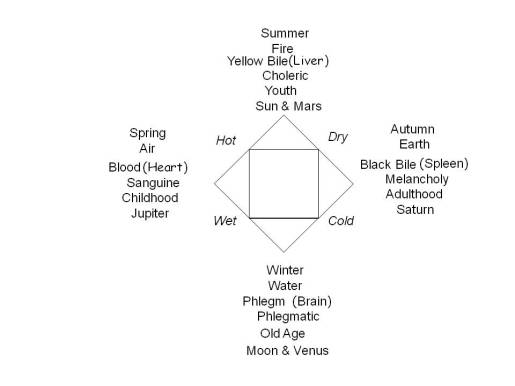
Galen’s (c.129-210) theory of medicine was developed from Aristotle and closely linked to the four elements of air earth fire and water. The four humours, blood, black bile, yellow bile, and phlegm corresponded to the elements in that order. Galen located the humours in appropriate organs, associated them with a developmental process, and connected them to the seasons of the year and to astrology.
The stability and power of the Aristotelian world view was mirrored in the astonishing longevity of its medical offshoot, Galenic medicine. Like Aristotle’s physics, Galenic humoral medicine remained the dominant western medical framework for almost 1600 years. The figure below has been included in medical text books in various forms and with different degrees of elaboration up to and including the nineteenth century.

According to Galen, a healthy person is someone whose four humours are in equilibrium. When they are out of kilter, medical interventions are meant to rebalance them. Diseases can be hot or cold, wet or dry, and cures prescribed hot remedies for cold diseases, wet remedies for dry diseases and so on. I was startled when I realized that, however unconsciously, we still make use of these ideas when we provide “hot” chicken soup as a remedy for the common “cold.”
The humours are not merely bodily fluids. They refer to people’s character and identity and are also connected to their social and physical environments. Because temperament and physiology are considered by Galen to be interactive, being angry, for example, might increase the flow of black bile or vice versa: the environment might stimulate the flow of black bile and make someone angry.
Thus illnesses were called “distempers” and regimens were prescribed to “temper” or harmonize the humours. Many rebalancing interventions commonly part of Galen’s prescriptions for regaining health, continue to be prescribed today: for example, changes in climate and adjustments of lifestyle such as diet and exercise. Galenic medications remain a large part of the naturopathic medicine cabinet. Other direct interventions like cupping, purges and bleeds continue to be used. When Gwyneth Paltrow, the movie star, was asked about the four brownish circles on her back, she declared that applying hot cups to create a vacuum and extract poisonous humours, made her feel significantly better. Sir William Osler one of the founders of modern medicine continued to bleed patients into the 1920s.
Finally the humors were connected to the world in a very particular way so that every person’s temperament is different and linked to the state of the universe at their time of birth. Medicine was highly individualized. In order to balance someone’s humours it was necessary to know the date and time of their birth and an astrological chart would identify what a properly balanced set of humours would be for each person. It would also provide an initial analysis of their character. (This must bring to mind the ideas being floated these days about individualized medicine through DNA.) The reason for this is that the exact time of one’s entry into the universe gave them a different set of humoral characteristics. The link to the stars was a link to the Gods who were visible as planets and stars in the heavens.
Melancholy, black bile and Earth are under the sway of Saturn. Water and phlegm are categorized under the moon and Venus. Fire, choleric, yellow bile are listed under the sun and Mars; and air, together with sanguine blood are under Jupiter. This meant that each person’s balance was different depending on their time of birth and hence your horoscope was part of a complete medical diagnosis: it ascertains your innate tendencies.
Since the Seventeenth Century it has been fashionable for scientific researchers to attack Galen for his bad medicine. Indeed a whole book called Bad Medicine points out all the outlandish practices attributed to Galen. One of the major elements of Galen’s practice was the development of dietary regimens for his patients and a nutritionist who reviewed one of them said that if someone stayed on such a diet for six months they would be dead. As far as I can tell this just goes to show that compliance was as much a problem for physicians in Galen’s day as it is today: there are few records of patients dying as a result of Galen’s regimens.
Perhaps at this point it may be useful to point out, as most general practitioners know, most minor conditions will improve in time without any intervention at all; many conditions are time bound and heal themselves, large numbers of patients are the worried well and finally the course of chronic diseases remains uncertain and in many cases does not easily respond to treatment. So we can accept that Galenic physicians, despite a non-scientific theoretical frame, remained the most revered academic professionals for over 1500 years. Their patients respected and returned to them for ongoing treatment and kept them close during the decline and death of a family member. Galenic medicine stood the test of time and remained the basis of medical textbook well into the 19th Century.
